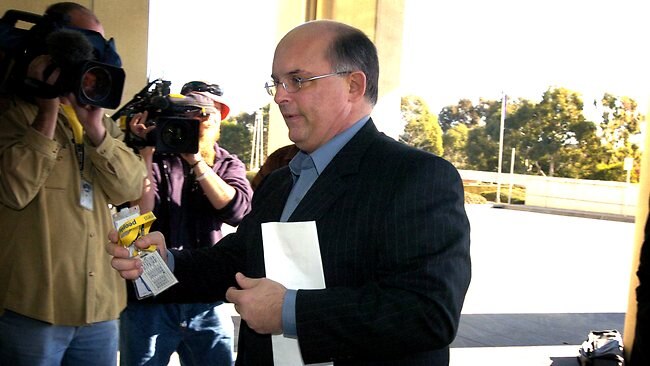Asylum-seeker privacy or immigration censorship?
THE media are being given access to immigration detention centres, but only if they allow their work to be vetted.

INSIDE Christmas Island's family camp early last year, guards and immigration officials were very worried about orphan Seena Akhlaqi Sheikhdost.
The nine-year-old, who lost his parents in the December 2010 boat disaster, was known in his compound as the boy with the blank stare.
When The Australian on February 15 last year published details of Seena's sad struggle, his wish to go to school with other children and a photograph of him in his island compound, Immigration Minister Chris Bowen came under instant pressure to move the Iranian boy out of detention and into the community in Sydney to live with members of his extended family.
As Bowen's department made plans to release Seena, an investigation was also under way in the department to find out who had leaked the story and who had taken Seena's photograph and passed it to this newspaper.
The Department of Immigration and Citizenship objects to the identification of asylum-seekers for a range of reasons that it has outlined repeatedly since it launched a controversial new media policy in October.
For the first time, the department is allowing media outlets into detention facilities, but on the proviso the journalist and camera operator or photographer accompany a department official, follow the official's instructions at all times and hand over images for vetting before publication.
The department is also putting pressure on media watchdogs to rein in media outlets that continue to show the faces of asylum-seekers. It has written to the Australian Communications and Media Authority, which sets standards for the telecommunications, broadcasting, radio and online media, urging it to use new privacy guidelines to crack down on the use of footage of asylum-seekers. The Immigration Department considers many of the images broadcast of asylum-seekers to be gratuitous and unjustified.
The broadcasting watchdog has posted the privacy guidelines on its website and concedes they could be used to force television stations to blur the faces of asylum-seekers. The Immigration Department says it may use the guidelines, which create a protection of "seclusion" even in a public place, to pressure broadcasters to do just that.
The department also has its sights on newspapers' use of images of asylum-seekers. An Immigration Department spokeswoman confirmed yesterday that it was considering a similar submission on restricted use of images to the Australian Press Council.
The debate has drawn in refugee advocates, human rights lawyers and media bosses. Opinions are not black and white. Even those who believe some sections of the media have misused images of asylum-seekers have acknowledged that, in the right context, such images can promote understanding and empathy.
Paris Aristotle, who has worked with traumatised refugees for more than 20 years as director of the Victorian Foundation for Survivors of Torture, has publicly shared his views on the power of humanising images in the debate about asylum seekers.
During a panel discussion at the Human Rights Forum 2011 at Sydney Town Hall in May, Aristotle told the audience of 1500: "If you paint a group of people coming to Australia as a faceless horde of invaders that may be terrorists and run a poll in the Herald Sun or whatever, you will of course get 95 per cent saying don't let them in. But my personal view is that if you take a mother and her children off that same boat and put them in front of that same group of Australian people, a very high percentage will say, 'We don't mean them'. And that is the challenge we have got."
Under new deeds of agreement to be signed by media organisations wishing to enter a detention facility, the department will stipulate which images are to be deleted, which are to be pixelated, which audio must be muted and whether certain elements must be deleted altogether.
The policy was intended to improve media access and, quite possibly, begin to mend the difficult relationship between the department and journalists frustrated by a lack of information.
But it has had the opposite effect in some quarters.
The West Australian's editor-in-chief Bob Cronin told the federal government's media inquiry last month that the Immigration Department's access terms were so outrageous that "no editor worth two bob would agree".
Even human rights lawyers with stated concerns about detainees' privacy have acknowledged the benefits of media coverage sometimes outweigh the risks.
Sydney solicitor George Newhouse of Shine Lawyers, who took up Seena's case last year, says asylum-seekers should be, and are, entitled to the same rights to privacy as any other person.
"I'm not criticising The Australian in any way. Ironically, the reporting has probably helped a lot of asylum-seekers on Christmas Island," he says.
"Some (asylum-seekers) will want their images to appear in the media and others won't.
"The critical issue is to obtain the relevant asylum-seeker's informed consent.
"What is disingenuous about DIAC's concern about the personal privacy of detainees is that the department, Customs and (DIAC's contractor) SERCO make it difficult, if not impossible, for the media to contact asylum-seekers. That approach means that the department, Customs and SERCO are effectively censoring all images of detainees by denying them the ability to consent."
The department says it has obligations to detainees under the Privacy Act. It also stresses that the family of an identified detainee can be put at risk back in the detainee's home country.
Also, an asylum-seeker identified in the media could obtain a visa they might otherwise not have received. This is called a sur place claim. Lawyers say such claims are rare but not unknown. The asylum-seeker can claim - successfully - that it is no longer safe for them to go home once they have been identified in their former country as an asylum-seeker.
Immigration Department national communications manager Sandi Logan yesterday said the new media access policy was similar to the media policies of a range of government agencies in Australia and overseas, including prisons, hospitals and education centres.
Logan said the department had received feedback from journalists, academics and the Media, Entertainment and Arts Alliance.
"Some of them thought it was completely unacceptable, some of them said we can work with it, and some of them said it was very good," he said.
Logan would not be drawn further, though it is known the MEAA has difficulties with the policy.
"It's important for asylum-seekers to be able to present themselves to the Australian people and tell their stories," MEAA federal secretary Chris Warren said yesterday.
The new detention centre media access rules were launched after South Australian Nigel Hopkins successfully negotiated access to the Inverbrackie detention facility for families. Hopkins, who runs a corporate communications consultancy after a career as a journalist at The Sun in London and later Adelaide's The Advertiser, says he offered to show part of his feature story to the Immigration Department before publication.
Hopkins says he also agreed verbally that the department could see photographs before publication and insist on pixelation if it felt a person was identified.
The story, "Inside Inverbrackie", ran in the glossy quarterly Adelaide Hills Magazine and won last year's Walkley Award for community and regional affairs. The story contained no interviews with asylum-seekers but there was information about the detainees' living conditions, an interview with the facility manager and an account of blunders the Immigration Department had made in dealing with the community.
Hopkins, who lives near the Inverbrackie facility, says he wrote the story for his community.
It did not occur to him to enter the story in the Walkleys, although he was honoured when his editor did and it won.
Hopkins says he thought carefully about offering to allow the department to see part of the story and the pictures. "It's not something you do with every story, because you can get into a bit of a bingle, but in this case I thought it was justified," he says.
Logan has described the story as the "precursor" to the new media policy and the deeds of agreement. Hopkins, however, says the deeds are "unfortunate" and not something he would have signed; building trust was the best way for journalists and media managers to operate.
Australian Press Council chair Julian Disney said he could see the need for some restrictions on the media's access to detention centres but he believed the Immigration Department's new policy went too far.
Professor Disney said the Press Council would seek talks with the Immigration Department before making a public statement on the matter at or before its next meeting in February.
"As far as we are concerned their new rules go further than is necessary given the fundamental importance of freedom of speech and access to information," he said.
The Immigration Department stresses that, under its new policy, reporters would not be requried under the new deeds to submit their stories for vetting.
As for Seena, he is in the care of a loving aunt and uncle in Sydney and said to be doing OK since his expedited release from detention.




